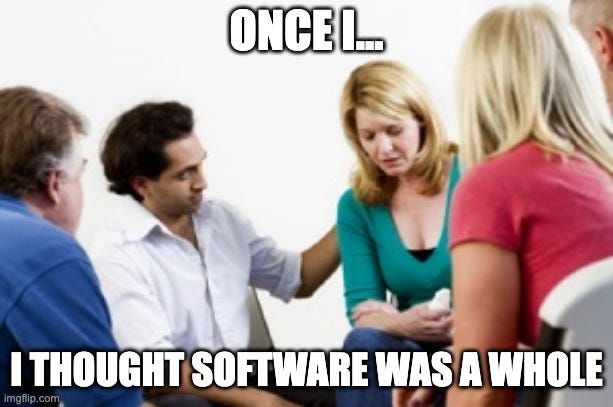There are many people all over the internet questioning why schools don't teach about taxes, mortgages, or interest rates.
But, before taxes and mortgages, why not teach about parts and wholes and how they relate?
This is what mereology is about. What is mereology? Mereology is the study of parts and the wholes said parts form. Mereology emphasizes the—complicated term drum roll—meronomic relation between entities. Say what? Allow me to add some more sophisticated jargon. A meronomy or partonomy is a type of hierarchy that deals with part–whole relationships, in contrast to a taxonomy whose categorization is based on discrete sets. The study of meronomy is then known as mereology, and for example in linguistics a meronym is the name given to a constituent part of, or a member of something. In short: "X" is a meronym of "Y" if an X is a part of a Y. Enough of complicated words.
Why do we even care? Can we just sit back, relax and not think about parts and wholes at all?
Not really. Poor, half-baked part-whole definitions cause a lot of trouble if left unchecked. This is an incredibly underrated problem which transpires as perhaps one of the most pervasive pitfalls in everything we do.
We structure things badly, simply because we think about them badly.
Think of a software engineer being given the power to decide what object or data structure contains what other objects or structures, and how those are supposed to communicate with other composite objects. In short, the engineer is tasked with providing a “box” or “crate” which is supposed to manifest a certain functionality for a customer—mind a customer can be internal or external, doesn’t matter—and then she is happily left alone to her elements to decide not only the contents of the crates but also how to arrange all objects inside the crate. Who checks that the software engineer has her mereology together? *shrugs*
And, yeah, one small thing: software is never a whole but a PART. Like bolts are. Fight me.
And you don’t need to be Aristotle for getting this, you just need a functioning brain. Software is always a part of something else. That ‘something else’ can be an aircraft, a smartphone, a pacemaker, a refrigerator, an airline ticketing system. It’s always amusing to see someone being christened as “Head of Software” or similar in an organization which sells systems. Good luck resolving the friction of leading a bit of everything that contains software and nothing wholly at the same time1. Like being “Head of Screws And Washers”. Been there, done that.
Similar challenges for someone starting a documentation tree. Or a work breakdown structure (WBS), or a product tree for an ERP tool. Or a relatively straightforward task which still contains subtasks. We suck at it: we coarse things down in favor of aBsTrAcTiOn but in the end reality calibrates us as way more granular than expected. No wonder everything takes longer than planned and costs more than estimated.
At any given time, someone, somewhere around the world is screwing up the parts and the wholes of something, or inverting a category, fully convinced that a feline is a type of tiger. Or calling something a simple when it’s a gunk.
When you mistake gunks for simples because you ignore the underlying granularity, you are kind of forgiven. But when you do know, or worse, someone is repeatedly telling you what you think are simples are in fact as gunky as they can be, well, you deserve to be slapped by a reality check. Imagine Niels Bohr telling you ‘hey, I think there’s more than just molecules‘ and you disregarding poor Niels over and over.
Parts and wholes are embedded in everything we own and we operate, and how we think. And it is not just about piling up parts and believing they magically become wholes. It’s also fundamentally about how we arrange the parts. Anyone who is at all mechanically inclined or who is interested in actually riding a motorcycle will attest to the importance of the distinction between a motorcycle in running condition and its disassembled parts. Surprisingly, this difference, which must strike us as both trivial and nevertheless crucial, has been de-emphasized, almost to the point of completely disappearing, in much of the theorizing about parts, wholes and objects that has taken place in literature during the last one hundred years or so. Are you kidding me? Intellectuals left aside the fact that the way you arrange parts of a whole is of some relevance? How can this be? Part of the story, as outrageous as this might sound, is simply a historical accident. As Peter Simons’ book, Parts: A Study in Ontology (Simons 1987) states, the most popular and well-worked-out theory of parts and wholes, which came to dominate this topic in the 20th century, just happened to be designed by people who were not particularly interested in the distinction between, say, a motorcycle in running condition and its disassembled parts2.
And it seems the disregard for the difference between a pile of motorcycle parts versus the motorcycle in working condition has passed generation after generation until today, here and now, where people arrange things in painfully loose manners, while being completely unaware and unbothered they are doing so.
Don’t be part of the problem.
…
Here’s where evangelists of matrix organization and other fictionary tales get triggered.
Adapted from Koslicki, Kathrin (2008). The Structure of Objects. Oxford University Press.




